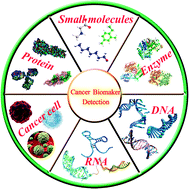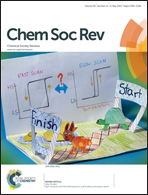Cancer biomarker detection: recent achievements and challenges
Abstract
The early detection of cancer can significantly reduce cancer mortality and saves lives. Thus, a great deal of effort has been devoted to the exploration of new technologies to detect early signs of the disease. Cancer biomarkers cover a broad range of biochemical entities, such as nucleic acids, proteins, sugars, small metabolites, and cytogenetic and cytokinetic parameters, as well as entire tumour cells found in the body fluid. They can be used for risk assessment, diagnosis, prognosis, and for the prediction of treatment efficacy and toxicity and recurrence. In this review, we provide an overview of recent advances in cancer biomarker detection. Several representative examples using different approaches for each biomarker have been reviewed, and all these cases demonstrate that the multidisciplinary technology-based cancer diagnostics are becoming an increasingly relevant alternative to traditional techniques. In addition, we also discuss the unsolved problems and future challenges in the evaluation of cancer biomarkers. Clearly, solving these hurdles requires great effort and collaboration from different communities of chemists, physicists, biologists, clinicians, material-scientists, and engineering and technical researchers. A successful outcome will result in the realization of point-of-care diagnosis and individualized treatment of cancers by non-invasive and convenient tests in the future.


 Please wait while we load your content...
Please wait while we load your content...